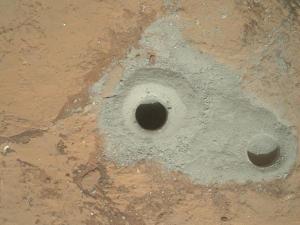By JoAnna Wendel
The Martian quest for NASA’s roving laboratory Curiosity isn’t all about landings and lasers. Humbler experiments are now giving clues about the makeup and history of the red planet.
Drilling under the surface and analyzing rock layers could reveal organic materials that hint at past life on Mars, said Mars Science Laboratory mission scientist John Grotzinger during a February 15 symposium at the American Association for the Advancement of Science meeting in Boston.
Curiosity's first sample drilling reached 6.4 centimeters deep on February 8, Curiosity's 182nd day of operation. Credit: NASA/JPL-Caltech/MSSS 2013Curiosity landed in August 2012 within about 2 kilometers of its target at the base of a Mars mountain called Mt. Sharp, in the now well-known Gale Crater. The landing more than 560 million kilometers away was so accurate that Grotzinger likened it to aiming a golf ball from Tokyo at a specific window in the Empire State Building and missing by just one window. The accuracy of the landing systems gave scientists a rare privilege: a targeted landing site.
“This represents the first time in the history of the exploration of Mars that the science team got to choose between” landing sites, Grotzinger said.
After intense debate, the scientists chose Gale Crater because of its diverse mix of geological features: the 5.5-kilometer-high Mt. Sharp; the crater’s rim, which holds secrets of Mars’s geological history; and a fan-shaped formation called an alluvial fan, left over from sediment deposited by flowing water.
Curiosity has been exploring Gale Crater for about 190 Martian days, shooting rocks with lasers and analyzing cups of soil, among other experiments. Its mission is to find organic materials that could indicate past life on Mars. Monitored by more than 420 scientists from 25 institutions and 15 countries, Curiosity has been churning out data nonstop.
“The amount of data we get every day with everything functioning as well as it has is almost overwhelming,” Grotzinger said.
Data-collection efforts can be hampered by the effects of solar and cosmic radiation that degrades organic materials on the surface. But even centimeters below the surface lies material protected from radiation. So in early February, NASA scientists turned to Curiosity’s drill.
“Drilling is the best chance we have to get down below the surface to give us the best chance at making a discovery,” Grotzinger said.
It will take at least a week for material collected to make it up the drill stem and into Curiosity’s inner laboratory for analysis.
Curiosity’s ultimate mission is to explore Mt. Sharp, but for now engineers will point it in the direction of Gale Crater’s 2-kilometer-high rim. Scientists have noticed that the lower layers of the rim have materials that could contain water, whereas the upper layers of the rim don’t seem to have such materials. That difference could point to a crucial transition period in the planet's past, Grotzinger noted.
“We might well be [crossing] the boundary in the history of Mars when the planet went from being more Earthlike — cold and wet, to more Marslike — dry.”
JoAnna Wendel is a senior at the University of Oregon, where she is pursuing a degree in General Science. She contributes articles to the UO's research news page, uoresearch.uoregon.edu. Reach JoAnna at joannarwendel@gmail.com or follow her on Twitter @JoAnnaScience.

